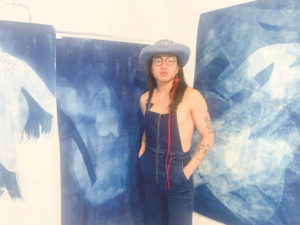
As an artist and as a person, the Fine Arts Work Center fellow Antonius-Tín Bui (they/them) hopes to remain in motion, in flux, ever-changing, questioning, evolving, challenging expectations, and resisting complacency and conformity alike.
“Whenever people ask me to introduce myself,” Bui says, “I like to say, ‘Xin chào!’ Which is the very formal way of saying hello in Vietnamese. ‘My name is Antonius-Tín Bui. I am a poly-disciplinary artist from the planet Jupiter.’ That used to be a joke, as a way to deflect the question that I always get — ‘Where are you from?’ Which, I think, is a very xenophobic question, at times. I much prefer people to ask, ‘Where do you consider home?’ Or: ‘Where do you most feel yourself?’ ”
Identity, for Bui, is not static. “I truly believe in queer as a verb — queer as in to challenge, to investigate, to radicalize,” they say. “I often think about the importance of queer in my own practice, or queer in an institution when I enter it. When I go somewhere, I think a lot about what is missing, who is being ignored, who is being silenced.”
For a solo show at the work center with an opening reception this Friday, Bui has created a series of cyanotypes —photographic monoprints made without a lens. The paper turns cyan when exposed to light, leaving silhouettes of white where the light has been blocked.
Born in the Bronx, N.Y., Bui is the second of four children whose parents fled Vietnam by boat in their teens. “Growing up Asian-Pacific-Islander-American, many of us are accustomed to silence, and we learned to navigate what’s unsaid,” they say. “My artwork has been a way to unearth histories and allow for conversations to begin within my family and my community. I’ve been thinking about how we approach topics filled with trauma, fear, and rage in intentional ways. I am constantly trying to find visual language that allows us to re-examine trauma, as opposed to reliving it.”
Bui has been trying to collect áo dàis, traditional Vietnamese garments worn by both sexes, to incorporate them in art projects. “Because this work is so personal to my entire family, they’ve become really invested,” Bui says. “They forwarded my open call to communities all over the country, and we’ve received garments from California, Denver, Houston, New York, and we’re hoping to just continue gathering for the next five years. Within just a month we have already received 65 garments.”

The cyanotypes in Bui’s FAWC show were made using “a combination of these donated áo dàis, water of Provincetown, found wood, fishing nets, and tarps — materials evident throughout archival images of our diaspora.”
The áo dàis will also be part of an annual intervention, called The Missing Piece Project, in front of the Vietnam Veterans War Memorial in Washington, D.C., which Bui will be participating in with the organization VietUnity. “I’m envisioning floating 150-plus of these colorful garments above the wall,” they say. “I’m envisioning the contrast between our rich vibrant culture with the reflective black wall that does not reflect our past or our names.”
Along with the cyanotypes, Bui’s FAWC show will include a project made of joss paper. “I weave joss paper together to form a canvas, which I then burn with archival images of the Vietnam War,” they say. It’s a way of “burning” images into memory, such as villagers fleeing napalm bombs during the war. “I am terrified of our culture’s desensitization to atrocities,” Bui says. “This is something that we must confront and work to repair.
“I am so genuinely honored to be among the 19 other fellows here,” Bui says, “I adore being around this extremely diverse array of thinkers. I have learned so much from them, and, to be completely honest, this has been one of my favorite residencies. Being here has changed my relationship to nature.”
Every day they’ve been at FAWC, Bui performs a ritual. “I do daily dances in the courtyard as a way of instilling play within my spirit,” they say. “It is too easy for us as artists to conform to a capitalistic market just to survive, so it is important for me to always engage in works that I never intend to exhibit. I am an untrained dancer. In fact, a lot of my work is unskilled. I really enjoy entering any body of work with a beginner’s mind and seeing what improvisational practices can lead to. For me, the dances in the FAWC courtyard are a reminder of the ephemeral quality of artwork, as well as a reminder to do things purely for myself and my body.”
Like all of Bui’s art, the dancing is in flux. “I also like that I can try out a movement or choreography that originates in my observations around P’town,” they say. “For instance, if I’m walking down Commercial Street and I really enjoyed the way someone walks or carries a purse, I might incorporate it. I might take a simple movement, like a hand flick, and see where it goes.”
Cyan of the Times
The event: Opening reception of an exhibit of work by Antonius-Tín Bui
The time: Friday, Feb. 14, 6-8 p.m.
The place: Fine Arts Work Center, 24 Pearl St., Provincetown
The cost: Free



